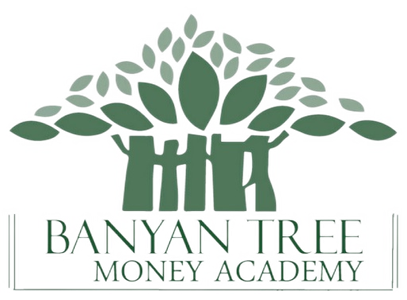Banyan Tree Money Academy

OUR EXCITING CURRICULUM FOR THE “RINGGIT SAVVY GENERATION” IN TEACHING EFFECTIVE MONEY HABITS CONSISTS OF:
Please click on the red box (age category) to view the information of each module.
- “THE SEED MODULE” FOR AGES 5-6 YEARS ( LEVEL 1 )
- “THE ROOT MODULE” FOR AGES 7-12 YEARS ( LEVEL 2 )
- “THE SHOOT MODULE” FOR AGES 13-18 YEARS ( LEVEL 3 )
- “THE TREE MODULE” FOR COLLEGE, UNIVERSITY & NEWLY WORKING ADULTS ( LEVEL 4 )
This module will introduce the history of money and its uses to our younger kids. In addition, an introduction to coin/currency is included to enhance young children’s interest and curiosity in money.
The basic personal finance terms of to earn, spend, save, invest and donate in the context of making economic decisions or choices with money is incorporated. Furthermore, the concepts of philanthropy and common good will be taught and reinforced to stimulate the young minds.
Objectives of this module are as below.
The learner will :
1) Describe the history of money and its uses
2) Describe the various coins/currencies available in Malaysia
3) Define important words eg. to earn, spend, save, invest and donate
4) Describe the many choices one can make with money
5) Describe ways to save money and places related to saving
6) Define philanthropy (philanthropist)
Aims.
By the end of this module, the learner should:
1) Understand the history of money and its uses
2) Identify the various coins/currencies available in Malaysia
3) Appreciate the various financial concepts of eg. to earn, spend, save, invest and donate
4) Appreciate the role of banks
5) Understand roles of a philanthropist
This module is designed to teach children how to get smart about money. Also, it deepens parents’ understanding of how children should relate to money. The basic terms of want and need, allowances and spending plans and budgeting are incorporated.
Objectives of this module are as below.
The learner will :
1) Describe the difference between wants and needs
2) Define allowances and illustrate spending plans
3) Describe a budgeting plan
Aims.
By the end of this module, the learner should:
1) Understand what are wants and needs
2) Identify what is allowance and set up a spending plan
3) Appreciate the art of budgeting
This module is designed to teach teenagers on to how to save money. It also provides an in-depth knowledge on the various ways to save. Insights are provided to where we can save money too. It is bound to be exciting to our today’s teens that are more used to spending mostly. Overviews of the various types of saving plans in Malaysia are provided. We also educate these youngsters on the various banks available in the local setup. An introduction to what is interest is provided in this exciting module.
Objectives of this module are as below.
The learner will :
1) Describe saving of money and the need to save
2) Illustrate various methods to save money
3) Describe places where he/she can save
4) Describe the various types of savings in the local context
5) Enumerate the various banks in the local set-up
4) Describe what is interest rates and the ways to estimate it.
Aims.
By the end of this module, the learner should:
1) Understand what is saving and the need for it
2) Identify methods to save money
3) Appreciate places one can save
4) Identify various types of savings and the local banks in Malaysia
5) Appreciate how to calculate interest rates
This module is designed to teach COLLEGE, UNIVERSITY AND NEWLY WORKING ADULTS about money and taxes. Also, the exciting world of paperless spending globally is introduced ie. Credit cards. The goods and evils of credit card are introduced. Overviews of risks are introduced and the need to invest in insurance is highlighted too in this important module. Lastly, the benefits of doubling and tripling money are provided through the important topic of investment and successful investment choices.
Objectives of this module are as below.
The learner will :
1) Describe taxes
2) Illustrate the advantages and disadvantages of credit cards and cheques
3) Describe risk involved with money including insurances
4) Enumerate investment and its benefits
Aims.
By the end of this module, the learner should:
1) Understand what are taxes
2) Identify the various uses of credit cards and cheques including the advantages and disadvantages
3) Appreciate risk involving money including insurances
4) Appreciate investments and its benefits
